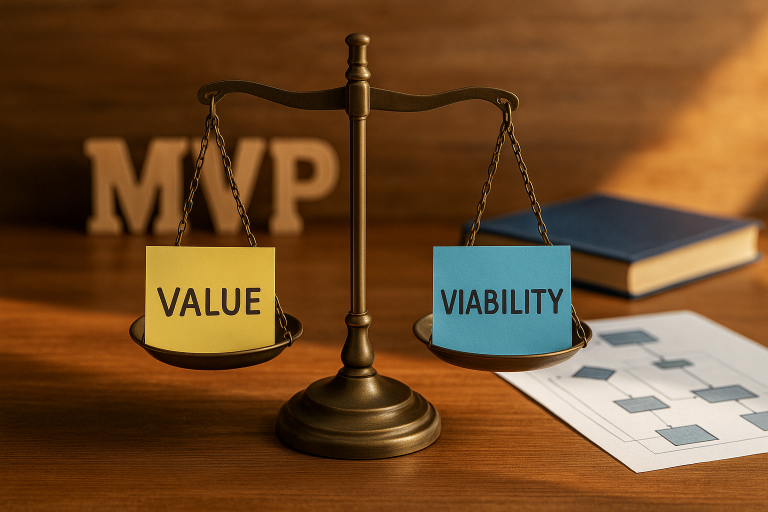Building an MVP is less like constructing a miniature version of your final product and more like running a series of scientific experiments. Each experiment asks two critical questions in parallel:
- “Do users care enough to change their behavior?” (Value)
- “Can we serve those users sustainably?” (Viability)
Get either answer wrong and the business crashes—either slowly through churn and apathy or suddenly through blown budgets and technical meltdowns. This article dives deep into how to strike that balance, layering field‑tested tactics, real‑world case studies, and a hands‑on four‑week playbook. We’ll also show how story‑mapping tools such as StoriesOnBoard keep teams laser‑focused on what matters most.
What exactly is “value”?
Value isn’t a feature list; it’s the delta between a user’s life before and after using your product. To quantify that delta:
- Severity interviews: Ask target users to rank their top frustrations from 1 (minor annoyance) to 10 (mission‑critical). Stick to problems scoring 8+.
- Outcome metrics: Identify one behavioral change that signals value—e.g., time on task, error rate, or revenue captured.
- Emotional resonance: Listen for “That would be amazing!” The enthusiasm gap is often more predictive than raw numbers alone.
Case in point: Calendly’s initial landing page (2013) promised to eliminate email ping‑pong. Early sign‑up velocity confirmed the pain was acute and widespread.
Understanding “viability” in three dimensions
While value is outward‑facing, viability looks inward:
- Technical Feasibility
- Latency: Can the MVP deliver its promise within acceptable response times?
- Reliability: What’s the cost of downtime? A social app can tolerate more hiccups than a payment gateway.
- Economic Sustainability
- Unit economics: Calculate gross margin after infrastructure costs.
- Acquisition cost: Use small paid‑ad tests to estimate real CAC.
- Compliance & Risk Alignment
- Data handling: Map personal data flows; ensure GDPR/CCPA compliance.
- Ethical checks: Consider potential biases in algorithms and datasets.
Mini‑story: A fintech startup once validated value by manually approving loans in 24 hours. But they folded because fully automated credit checks required third‑party APIs that quadrupled per‑user costs—an overlooked viability pothole.
The value‑viability matrix (with examples)
| Low Viability | High Viability | |
|---|---|---|
| High Value | Sweet Spot Example: Figma’s browser‑based design tool—high collaboration value, SaaS margin model. | Backlog Fodder Example: internal analytics dashboard v2—nice to have but not urgent. |
| Low Value | Dead EndsExample: yet another social check‑in app circa 2012. | Dead Ends: Example: yet another social check‑in app circa 2012. |
Plot each hypothesis on this grid during sprint planning; it clarifies where to invest, pivot, or kill.
Validating value first—without breaking the ban
- Explainer video (Dropbox playbook): 3‑minute screencast to collect waiting‑list emails.
- Fake‑door test: Add a “Request Demo” button that leads to “Coming Soon” plus opt‑in.
- Wizard‑of‑Oz: Simulate tech with humans—e.g., Deliveroo founders delivered meals themselves to gauge demand elasticity.
- Story Mapping with StoriesOnBoard: Break the user journey into activities, steps, and details; then slice the first release to include only the critical path.
Each tactic costs less than a week and yields actionable conversion data.
Ensuring viability concurrently
Even while value tests run, gather viability evidence:
- Technical spikes: Build “vertical slices” to measure API costs and latency on real data.
- Pre‑orders / LOIs: Charge a discounted annual fee upfront; send invoices via Stripe or Lemon Squeezy.
- Cohort cost tracking: Use Airtable to log infra hours and support tickets by cohort; spot ballooning costs early.
- Regulatory sandboxing: For health/finance, run pilots in isolated data environments with compliant logging.
Common trade‑offs & mitigation strategies
| Trade‑off | Hidden Danger | Mitigation |
| Pixel‑perfect UI vs. Shipping Now | Delayed learning, rising opportunity cost | Ship usable ugly → iterate w/ A/B themes |
| Full Automation vs. Manual Ops | Upfront dev cost magnitudes higher | Manually serve 50 users → automate top pain points |
| High Scalability vs. Functional Simplicity | Premature infra spend | Use serverless + queued jobs until 10× traffic |
| Broad Target Market vs. Beachhead Niche | Diluted messaging | Pick one user persona; expand after PMF |
Measuring success: north‑star metrics
- Activation Rate – % of sign‑ups reaching the core ‘aha’ moment.
- Payback Period – Months to recoup customer acquisition cost.
- Support Tickets Per User – Early proxy for complexity and hidden costs.
- Referral Share – Indicates strong perceived value.
Set quantified targets (e.g., 40% activation within 7 days). If metrics miss, diagnose which side of the balance—value or viability is off.
A four‑week dual‑track playbook
| Week | Value Track | Viability Track | Friday Go/No‑go Criterion |
| 1 | 10 customer interviews & JTBD statements | Spreadsheet of cost drivers | Clear #1 pain ranked by ≥70% of interviewees |
| 2 | Smoke‑test landing page live | Unit‑economics model v1 (COGS + Gross Margin) | ≥100 email sign‑ups; projected gross margin ≥60% |
| 3 | Wizard‑of‑Oz concierge service | Tech spike proving ≤1‑second API response | ≥10 paid pre‑orders; infra cost per user < 20% of price |
| 4 | Functional prototype in user hands | Compliance checklist scored | Activation rate ≥40%; no red‑flag compliance gaps |
At the end of Week 4, evidence should clearly point to pursue, pivot, or perish.
Key takeaways
- Balance is dynamic. Early hypotheses often start in the Heartbreakers quadrant; use iterative scope cuts or pricing tweaks to shift right.
- Measure both sides continually. One‑sided validation yields false positives and expensive regrets.
- Tools matter. Story‑mapping in StoriesOnBoard keeps teams focused on the thin slice that maximizes learning for minimal build.
- Decide ruthlessly. If value or viability remains unproven after disciplined experiments, kill the idea and recycle the insight.
Bottom line: The winners aren’t those who build the most; they’re those who learn the fastest while staying solvent. Master the dance between value and viability, and your MVP will be a springboard—not an anchor.
